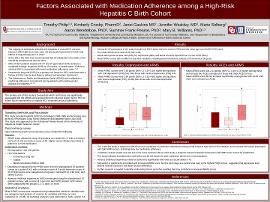| dc.description.abstract | BACKGROUND: Multiple studies of hepatitis C virus (HCV) reported that 75% of individuals infected with HCV were born between 1945-1965 and were previously never tested. Therefore, in 2012 the CDC published recommendations that all individuals in this birth cohort should be screened for HCV at least once. Adherence to treatment is essential to achieve a sustained virologic response (SVR) for HCV cure. Patients who do not complete the treatment are at risk of treatment failure. The Adherence to Refills and Medication Scale (ARMS) has been an effective tool for predicting adherence of medication treatment in cardiovascular disease and diabetes and identifying risk factors associated with nonadherence to treatment for these diseases. The purpose of this study is to elucidate which risk factors significantly influence the ARMS score among this birth cohort at risk for HCV to guide future HCV treatment protocol adherence.
METHODS: This study recruited patients born between 1945-1965 and accessing care at the OU Physicians-Tulsa Family Medicine clinic between March-July 2019. Data was collected using a prescreening survey consisting of demographics, questions related to HCV risk factors (blood transfusions, tattoos, and intravenous drug use), depression assessed with the PHQ9 tool, and adverse childhood experiences (ACEs). IVDU, ACEs, and PHQ9 were classified into groups. Mean ARMS scores were compared using t-tests for variables with two categories and analysis of variance for variables with three or more categories. All statistical analyses were performed in SAS 9.4.
RESULTS: Among the 75 participants in the study, most were women (57%) and the sample had a mean ARMS score of 16.32 (SD=3.45). About half reported depression (51%) and one-third reported four or more ACEs (33%). Mean ARMS scores were 2.983 points (95% CI: 0.70-5.26) higher among those with moderate depression (PHQ 5-14), and 2.699 points (95% CI: 0.65-4.75) higher among those with severe depression (PHQ 15-27) than those with a minimal depression (PHQ 0-4). Similarly, mean ARMS score was 2.61 points (95% CI: 0.34-4.88) higher among those with at least four ACEs compared to those with three ACEs or less. Mean ARMS scores did not differ for any other variables.
CONCLUSION: This is the first study to assess the ARMS score as a predictor of medication adherence and risk factors associated with the ARMS score in this high-risk birth cohort for HCV infection. These findings indicate that depression and ACEs may be risk factors for poor medication adherence in this population. | en_US |

